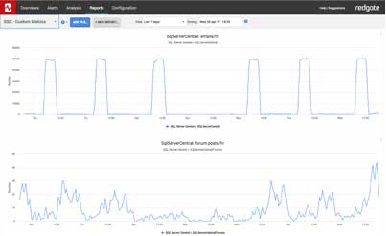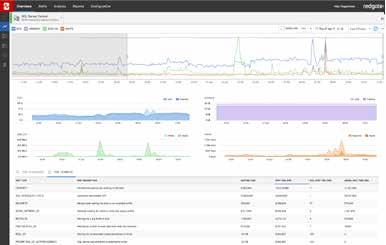Metrics install automatically if you have Redgate Monitor installed.
If you are using Redgate’s SQL Server monitoring tool, Redgate Monitor, you can instantly install and run this metric on your servers.
This metric returns the number of ‘login failed’ error messages found in the SQL Server error log file in the last hour.
The T-SQL for this metric uses the undocumented stored procedure: xp_readerrorlog. Once you’ve been alerted to login failures, you can find out why they occurred by running the procedure against the SQL Server error log file and searching for text similar to this:
|
1 2 |
2013-07-31 04:56:08.34 Logon Error: 18456, Severity: 14, State: 5. 2013-07-31 04:56:08.34 Logon Login failed for user '<user name>'. [CLIENT: <ip address> |
The error state corresponds to a specific reason for failure, for example, state 5 means the user entered an invalid userid. For details of each state, see: http://blogs.msdn.com/b/sql_protocols/archive/2006/02/21/536201.aspx.
You can create additional custom metrics that read different messages in the SQL Server or SQL Agent error log file by reusing an edited version of this T-SQL. You’ll need to update the parameters for the procedure:
|
1 |
EXEC sys.xp_readerrorlog 0, 1, N'Login', N'failed', @starttime, @endtime; |
For example, to be alerted when the DBCC trace flag has been enabled in the last hour, replace the procedure with:
|
1 |
EXEC sys.xp_ReadErrorLog 0, 1, N'DBCC', N'TRACEON', @starttime, @endtime;[ |
Note: There is a known issue with using xp_readerrorlog in SQL Server versions earlier than 2008 R2. The command may stop responding during execution and cause CPU usage to increase to 100%. For more details and links to fixes from Microsoft, go to http://support.microsoft.com/kb/973524.
Metric definition
Name
Failed SQL Server logins
Description
This metric returns the number of 'login failed' error messages found in the SQL Server error log file in the last hour.
The T-SQL query that will collect data
Instances to collect from
Select all
Databases to collect from
master
Collection frequency
3600
Note: If you've updated the T-SQL to read from the file more frequently, you should update the metric collection frequency to match.
Use collected or calculated values
Leave the Use a calculated rate of change between collections check box unchecked
Metric collection
Enabled
Alert definition
Alert name
Failed SQL Server logins
Description
Raise an alert when the metric value goes
Above the defined threshholds
Default threshold values
| High: | 0 |
| Medium: | |
| Low: |
Raise an alert when the threshold is passed for
1 collection
Alert is
Enabled
 32,752
32,752 
